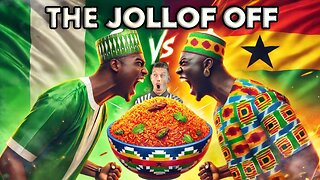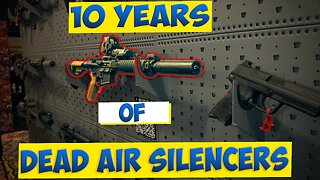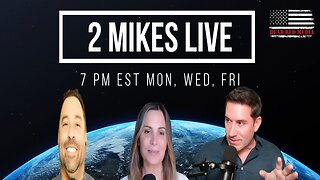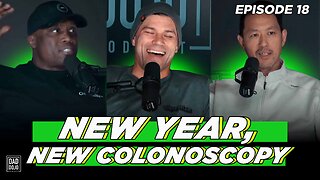Premium Only Content

48. Health Offer Mechanism
Category:
Brain/Memory
Product:
Supplement or Nutritional Guide.
https://www.sciencedaily.com/releases/2020/04/200402144504.htm
Date:
April 2, 2020
Source:
King's College London
Summary:
Researchers have shown that how we respond to changes in nutrients at a molecular level plays an important role in the aging process, and this is directed by some key genetic mechanisms.
Published in Communications Biology, the study explored the molecular interactions that occur in our response to varying levels of nutrients, otherwise known as nutrient-sensing pathways, as we grow older.
Using a combination of laboratory-based techniques and analysis of data on people's memory, diet and level of physical exercise, researchers identified a number of genes that are active in nutrient-sensing pathways and demonstrated these genes also show associations to performance on memory tasks in data from over 2000 individuals. The study identified that the genes ABTB1 and GRB10 were both influential in nutrient-sensing pathways and showed association to memory.
Previous studies have indicated that neural stem cells (NSCs) in the hippocampal part of the brain play an important role in the decline of our thought process and memory over time. NSCs are cells that keep dividing as long as they are alive and either make more NSCs or cells that have a specialist function in the brain. The maintenance of these NSCs is important in memory and is affected by environmental factors such as diet and exercise, potentially explaining some of the variations in how aging affects different people.
^^ SPG NOTE: Could be looking for nutrients that support neural stem cells.
Next Steps:
Get a little more information on neural stem cells
Look at nutrients/ingredients that have been shown to support them.
https://www.sciencedaily.com/releases/2020/02/200214134725.htm
Date:
February 14, 2020
Source:
DZNE - German Center for Neurodegenerative Diseases
Summary:
Memory performance and other cognitive abilities benefit from a good blood supply to the brain. This applies in particular to people affected by a condition known as 'sporadic cerebral small vessel disease'. Researchers suggest that blood perfusion of the so-called hippocampus could play a key role in age- and disease-related memory problems.
Inside the human brain, there is a small structure, just a few cubic centimeters in size, which is called the "hippocampus" because its shape resembles a seahorse. Strictly speaking, the hippocampus exists twice: once in each brain hemisphere. It is considered the control center of memory.
A team of scientists headed by Prof. Stefanie Schreiber and Prof. Emrah Duezel, both affiliated to the DZNE and the University Medicine Magdeburg, investigated this question. The researchers used high-resolution magnetic resonance imaging (MRI) to examine the blood supply to the hippocampus of 47 women and men aged 45 to 89 years. The study participants also underwent a neuropsychological test battery, which assessed, in particular, memory performance, speech comprehension, and the ability to concentrate.
"Our study shows a clear link between blood supply to the hippocampus and cognitive performance," Schreiber summarised the results. "This suggests that brain blood flow might play a key role in the declining of memory performance, whether caused by age or disease."
SPG: Make up a term like Cognitive Circulation. The mechanism would be basically something like: increased blood flow to the brain, aka cognitive circulation, supports better memory.
Next Steps:
Prove that’s true (that increased blood flow improves memory) and find nutrients that increase blood flow to the brain.
https://www.sciencedaily.com/releases/2019/08/190823140731.htm
Date:
August 23, 2019
Source:
Salk Institute
Summary:
Researchers have discovered that star-shaped cells called astrocytes help the brain establish long-lasting memories. The work could inform therapies for disorders in which long-term memory is impaired, such as traumatic brain injury or dementia.
Star-shaped cells called astrocytes help the brain establish long-lasting memories, Salk researchers have discovered. The new work adds to a growing body of evidence that astrocytes, long considered to be merely supportive cells in the brain, may have more of a leading role. The study, published in the journal GLIA on July 26, 2019, could inform therapies for disorders in which long-term memory is impaired, such as traumatic brain injury or dementia.
"This is an indication that these cells are doing a lot more than just helping neurons maintain their activity," says Professor Terrence Sejnowski, head of Salk's Computational Neurobiology Laboratory and senior author of the new work. "It suggests that they're actually playing an important role in how information is transmitted and stored in the brain."
The brain's neurons rely on speedy electrical signals to communicate throughout the brain and release neurotransmitters, but astrocytes instead generate signals of calcium and release substances known as gliotransmitters, some of them chemically similar to neurotransmitters. The classical view was that astrocytes' function was mostly to provide support to the more active neurons, helping transport nutrients, clean up molecular debris, and hold neurons in place. Only more recently, researchers have found that they might play other, more active, roles in the brain through the release of gliotransmitters but these remain largely mysterious.
In 2014, Sejnowski, Salk postdoctoral researcher António Pinto-Duarte and their colleagues showed that disabling the release of gliotransmitters in astrocytes turned down a type of electrical rhythm known as a gamma oscillation, important for cognitive skills. In that study, when the researchers tested the learning and memory skills of mice with disabled astrocytes, they found deficits that were restricted to their capacity to discriminate novelty.
SPG Notes^^: Focus on astrocytes and gilotransmitters as what needs to be supported for memory improvement.
Next Steps:
Look up more on astrocytes and gilotransmitters and confirm their importance for memory.
Find nutrients that support both.
https://www.sciencedaily.com/releases/2020/02/200211103731.htm
Date:
February 11, 2020
Source:
RMIT University
Summary:
Inflammation can send the brain's immune cells into damaging hyperdrive, an effect that has been linked to neurodegenerative diseases that affect memory, like dementia. A new study finds these same immune cells can also be activated to have the reverse effect, powering memory, and learning.
When it comes to memory, immune cells are known as the "bad cops" of the brain. But new research shows they could also be turned into "good cops" to power memory and learning.
In the new study, researchers at RMIT University found that these same immune cells -- known as microglia -- can also be activated to have the reverse effect.
When the microglia were altered in rats, their performance in simple memory tasks improved by up to 50%, rather than deteriorating.
While the effect was temporary, the discovery suggests these cells could be targeted in the development of new therapies designed to enhance memory formation, with the hope of preventing cognitive decline as people grow older.
Chief Investigator and senior author, Associate Professor Sarah Spencer, said the unexpected results of the study expanded our understanding of memory formation and the role of neuroinflammation in memory loss.
"Even in healthy adults, optimizing how well we learn and remember can give us a substantial performance edge at work and socially.
"Our study has for the first time shown a link between changes in the immune cells of healthy brains and improved cognitive function.
The study looked how the rats performed memory tasks when the immune cells were present and compared this with their performance when almost all the microglia were knocked out.
They found that removing almost all the microglia made no difference in memory tasks.
But when the microglia regenerated, this led to astounding results: researchers ran the same memory tests on the rats and they performed 25-50% better than normal rats.
Importantly, the regenerated microglia were a different shape -- similar to the "activated" shape that these cells have when dealing with inflammation.
"We are still exploring what makes these cells different when they repopulate the brain, but their shape tells us they may be more active than usual, potentially making the neurons more effective to encourage better memory," Spencer, an NHMRC Career Development Fellow at RMIT, said.
"The effect doesn't last. As the microglia go back to their usual shape, memory performance also goes back to normal.
SPG^^: Idea of immune cells in brain is interesting, or specifically brain’s immune system. Also microglia in the brain being activated and that increasing memory.
Next Steps:
Activating microglia (what happens, memory, what they are, etc) – does this support short-term memory improvements?
Nutrients that help activate microglia.
https://www.sciencedaily.com/releases/2019/03/190314075747.htm
Date:
March 14, 2019
Source:
Rutgers University
Summary:
How much vitamin D can boost memory, learning, and decision-making in older adults, and how much is too much? A unique study found that overweight and obese older women who took more than three times the recommended daily dose of vitamin D showed improvements in memory and learning -- but also had slower reaction times. The researchers hypothesize that slower reaction times may increase the risk of falling among older people.
^^ SPG Note: Vitamin D helps support neural stem cells. So interesting that it also supports memory. Makes sense.
The researchers, whose work is in the Journals of Gerontology: Series A, used computers to assess the impact of vitamin D on cognitive function. The researchers evaluated three groups of women between 50 and 70 years old in a randomized controlled trial.
One group took the recommended daily dose of 600 international units (IU), equivalent to 15 micrograms, of vitamin D each day for a year. Another group took 2,000 IU per day and the third took 4,000. All women participated in lifestyle counseling and were encouraged to lose a modest amount of weight.
The researchers found that memory and learning improved in the group that took 2,000 IU per day, but not in the group that took the higher dosage. Meanwhile, the women's reaction time showed a trend to be slower at 2,000 IU daily and was significantly slower at the higher dosage.
Study referenced: https://academic.oup.com/biomedgerontology/advance-article-abstract/doi/10.1093/gerona/glz041/5320009?redirectedFrom=fulltext
https://www.sciencedaily.com/releases/2020/01/200113153330.htm
^^ interesting, good paradoxical question, but a little complicated + talking about genetic factors.
https://www.sciencedaily.com/releases/2020/03/200305203531.htm
^^ some interesting stuff about how memory works.
https://www.sciencedaily.com/releases/2018/01/180129134354.htm
^^ just interesting because another thing about electrical stimulation, similar to Stanford study I viewed earlier. This one from the Mayo Clinic.
https://www.sciencedaily.com/releases/2018/05/180514132450.htm
Date:
May 14, 2018
Source:
Society for Neuroscience
Summary:
Memories can be transferred between organisms by extracting ribonucleic acid (RNA) from a trained animal and injecting it into an untrained animal, as demonstrated in a study of sea snails.
https://www.sciencedaily.com/releases/2020/04/200402144504.htm
Date:
April 2, 2020
Source:
King's College London
Summary:
Researchers have shown that how we respond to changes in nutrients at a molecular level plays an important role in the aging process, and this is directed by some key genetic mechanisms.
Published in Communications Biology, the study explored the molecular interactions that occur in our response to varying levels of nutrients, otherwise known as nutrient-sensing pathways, as we grow older.
Using a combination of laboratory-based techniques and analysis of data on people's memory, diet and level of physical exercise, researchers identified a number of genes that are active in nutrient-sensing pathways and demonstrated these genes also show associations to performance on memory tasks in data from over 2000 individuals. The study identified that the genes ABTB1 and GRB10 were both influential in nutrient-sensing pathways and showed association to memory.
Previous studies have indicated that neural stem cells (NSCs) in the hippocampal part of the brain play an important role in the decline of our thought process and memory over time. NSCs are cells that keep dividing as long as they are alive and either make more NSCs or cells that have a specialist function in the brain. The maintenance of these NSCs is important in memory and is affected by environmental factors such as diet and exercise, potentially explaining some of the variation in how aging affects different people.
^^ SPG NOTE: Could be looking for nutrients that support neural stem cells.
Next Steps:
Get a little more information on neural stem cells
Look at nutrients/ingredients that have been shown to support them.
On Neural Stem Cells
https://www.scientificamerican.com/article/stem-cells-for-memory/
Now a new animal study shows that the immature cells could also help with cognitive impairments. Frank M. LaFerla of the University of California, Irvine, and his colleagues showed that neural stem cells can reverse memory loss.
https://www.britannica.com/science/neural-stem-cell
Neural stem cells, largely undifferentiated cell originating in the central nervous system. Neural stem cells (NSCs) have the potential to give rise to offspring cells that grow and differentiate into neurons and glial cells (non-neuronal cells that insulate neurons and enhance the speed at which neurons send signals).
The generation of new brain cells in the adult brain was thought to be impossible since a new cell could never fully integrate itself into the existing complex system of the brain. It was not until 1998 that NSCs were discovered in humans, found first in a region of the brain called the hippocampus, which was known to be instrumental in the formation of memories. NSCs were later also found to be active in the olfactory bulbs (an area that processes smell) and dormant and inactive in the septum (an area that processes emotion), the striatum (an area that processes movement), and the spinal cord.
Undifferentiated cells, in the central nervous system, that can become new types of brain cells that support memory.
https://www.ncbi.nlm.nih.gov/pmc/articles/PMC2738865/
NSCs are self-renewing, multipotent progenitors residing in the nervous system. In the adult brain, NSCs are primarily located in the SVZ of the lateral ventricle and the SGZ of the hippocampal dentate gyrus
Do NSC’s Decline With Age?
https://www.ncbi.nlm.nih.gov/pmc/articles/PMC5316899/
However, there is now strong evidence for the aging-associated cognitive deficits, such as olfactory dysfunction, spatial memory deficits, and neurodegenerative disorders, which are caused by the deterioration of NSC proliferation and differentiation and enhanced NSC senescence as a consequence of aging[27,28].
https://www.ncbi.nlm.nih.gov/pubmed/22466406
The observation that aging has a negative effect on the proliferation of neural stem cells has prompted several laboratories to investigate new systems to artificially increase neurogenesis in senescent animals as a means to compensate for age-related cognitive decline.
https://www.ncbi.nlm.nih.gov/pmc/articles/PMC4725211/
Like satellite cells, NSCs decrease in number with age, which, in turn, contributes to decreased neurogenesis (Kuhn et al., 1996; Maslov et al., 2004).
Neurogenesis = Neurogenesis is the process by which nervous system cells, the neurons, are produced by neural stem cells (NSC)s.
https://www.ncbi.nlm.nih.gov/pmc/articles/mid/NIHMS336125/
Just another saying that with increased age, NSCs decline, and memory gets worse.
https://www.ncbi.nlm.nih.gov/pmc/articles/PMC2686327/
Although neurogenesis may contribute to the ability of the adult brain to function normally and be induced in response to cerebral diseases for self-repair, this nevertheless declines with advancing age.
Studies showing that NSCs support memory:
https://www.nature.com/articles/s41598-018-33017-6
When transplanted improves cognition (animal study).
https://www.ncbi.nlm.nih.gov/pmc/articles/PMC2738865/
NSC’s - Crucial for spatial learning and memory. Contributing to new memory formation. Supporting mood.
Mechanism of the Problem:
The way your brain supports itself and regenerates is through Adult Neural Stem Cells (NSCs). These are stem cells that come from your central nervous system, and are found in the hippocampus of your brain. The hippocampus is highly associated with mental performance and memory.
The ongoing creation (aka proliferation) of Adult Neural Stem Cells has been shown to support working memory, spatial learning, and the formation of new memories.
However, as we age, there is significant evidence suggesting that the creation (proliferation) of NSCs decreases. And that with fewer NSCs and slowed down activity, brain activity also slows down and memory suffers.
Mechanism of the Solution:
Is to support the ongoing creation (aka proliferation) of NSCs in the brain, and protect the ones that we already have. Doing so can support memory and mood and cognition, etc.
Specifically, here are ingredients that help to support the proliferation of NSCs and memory:
Vitamin D3 and NSC Proliferation:
https://www.ncbi.nlm.nih.gov/pubmed/26592821
We also identified through immunohistochemistry and western blotting that the vitamin D has the ability to trigger neural stem cells,
https://www.ncbi.nlm.nih.gov/pubmed/25681066
This vitamin significantly enhanced proliferation of NSCs, and enhanced their differentiation into neurons and oligodendrocytes, but not astrocytes.
https://www.ncbi.nlm.nih.gov/pmc/articles/PMC4400846/
Vitamin D3 enhances neural stem cell proliferation.
https://www.ncbi.nlm.nih.gov/pmc/articles/PMC6123560/
Improves the differentiation of Neural Stem Cells.
Vitamin D3 and Memory:
The researchers found that memory and learning improved in the group that took 2,000 IU per day, but not in the group that took the higher dosage. Meanwhile, the women's reaction time showed a trend to be slower at 2,000 IU daily and was significantly slower at the higher dosage.
^^ showing that Vitamin D supports memory.
https://www.ncbi.nlm.nih.gov/pubmed/26836174
^^ Deficiency = worse memory.
https://www.ncbi.nlm.nih.gov/pmc/articles/PMC5525144/
Same as above.
https://www.ncbi.nlm.nih.gov/pubmed/28167237
Nonverbal (visual) memory seems to benefit from higher doses of vitamin D supplementation, particularly among those who are insufficient (<75nmol/L) at baseline, while verbal memory and other cognitive domains do not. These findings are consistent with recent cross-sectional and longitudinal studies, which have demonstrated significant positive associations between 25(OH)D levels and nonverbal, but not verbal, memory. While our findings require confirmation, they suggest that higher 25(OH)D is particularly important for higher-level cognitive functioning, specifically nonverbal (visual) memory, which also utilizes executive functioning processes.
Other ingredients that support growth of neural stem cells:
https://www.ncbi.nlm.nih.gov/pmc/articles/PMC3991899/
Acanthopanax, Angelica, could maintain the survival of neural stem cells, and Rhodiola, Ganoderma spore Polygala, Tetramethylpyrazine, Gardenia, Astragaloside, and Ginsenoside Rg1 promoted proliferation of neural stem cells, and Rhodiola, Astragaloside promoted differentiation of neural stem cell into neuron and glia in vivo. Astragalus, Safflower, Musk, Baicalin, Geniposide, Ginkgolide B, Cili polysaccharide, Salidroside, Astragaloside, Antler polypeptides, Ginsenoside Rg1, Panax notoginseng saponins promoted proliferation and differentiation of neural stem cells in vitro. Salvia, Astragalus, Ginsenoside Rg1, P. notoginseng saponins, Musk polypeptide, Muscone, and Ginkgolide B promoted neural-directed differentiation of MSCs into nerve cells. These findings are encouraging further research into the Chinese herbs for developing drugs in treating patients of stroke and brain injury.
Rhodiola
https://www.ncbi.nlm.nih.gov/pmc/articles/PMC4249906/
This work points to the role of Rr in depression improvement and in stimulation of NSCs proliferation.
https://www.ncbi.nlm.nih.gov/pubmed/19260327
Rhodiola rosea may enhance the level of 5-HT and promote the proliferation and differentiation of neural stem cells in the hippocampus of the depressive rats, and may play a role in saving injured neurons of the hippocampus.
https://www.ncbi.nlm.nih.gov/pmc/articles/PMC3250459/
reduction of ROS levels and NSC death with simultaneous increases in proliferation and differentiation. Our findings indicated that the RCE improved the impaired hippocampal neurogenesis in the rat model of AD through protecting NSCs by its main ingredient salidroside which scavenged intracellular ROS.
https://www.ncbi.nlm.nih.gov/pubmed/19403286
In conclusion the results demonstrated that Rhodiola rosea extract could improve 5-HT level in hippocampus in depressive rats, and low dosage Rhodiola rosea could induce neural stem cell proliferation at hippocampus to return to normal level, repairing the injured neurons at hippocampus.
Human Trials on Rhodiola and Memory:
https://www.ncbi.nlm.nih.gov/pmc/articles/PMC3541197/
Panax Ginseng
Astragaloside
Ginkgolide
Safflower
Gardenia
Ginsenoside
Ganoderma Spore
Angelica = wild celery
https://www.ncbi.nlm.nih.gov/pubmed/30196146
ASP can delay aging speed by protecting NSCs and promote neurogenesis by enhancing the antioxidant and anti-inflammatory capacity, up-regulation of p53/p21 signaling pathway.
https://www.ncbi.nlm.nih.gov/pubmed/31208217
Collectively, AP alleviated hypoxia-introduced NSCs damages by maintaining cell viability, blocking apoptosis and autophagy via downregulation of BNIP3 with the activation of mTOR and Notch signaling pathways.
https://www.ncbi.nlm.nih.gov/pmc/articles/PMC4145944/
Our experimental findings indicate that Radix Angelicae Sinensis can induce human adipose-derived stem cell differentiation into neuron-like cells and produce less cytotoxicity.
Angelica + Memory
https://www.ncbi.nlm.nih.gov/pubmed/26821843
AS effectively rescued the symptoms of AD in a rat model by inhibiting inflammation, apoptosis, and NF-κB signaling pathway.
https://www.ncbi.nlm.nih.gov/pubmed/22846435
These results suggest that the memory ameliorating effects of INM-176 on scopolamine- or Aβ(1-42) protein-induced memory impairment are mediated, in part, via acetylcholinesterase inhibition and neuroprotective activities.
https://www.ncbi.nlm.nih.gov/pubmed/31905851
(3) Result: Angelica gigas improved spatial learning, working memory, and suppressed fear memory in the mild traumatic brain injury model. It also improved spatial learning and suppressed cued fear memory in the chronic mild stress model animals. (4) Conclusions: Angelica gigas can improve cognitive symptoms in mild cognitive impairment model mice.
https://www.ncbi.nlm.nih.gov/pubmed/29269276
Just another
https://www.ncbi.nlm.nih.gov/pubmed/23132631
And another
https://www.ncbi.nlm.nih.gov/pubmed/14687853
and another
-
 1:20:47
1:20:47
Redacted News
4 hours agoMexico CAVES to Trump over tariffs, USAID Shutdown, & Zelensky loses $200 billion | Redacted Live
143K363 -
 LIVE
LIVE
The StoneZONE with Roger Stone
1 hour agoIs GOP Sen. Bill Cassidy Playing Politics with RFK Jr. Vote as U.S. Faces Public Health Crisis?
717 watching -
 LIVE
LIVE
BIG NEM
4 hours ago📢 THE JOLLOF-OFF: The Battle for West African Cuisine! 🇳🇬🔥🇬🇭
52 watching -
 54:58
54:58
LFA TV
1 day agoThe Trade War Begins | TRUMPET DAILY 2.3.25 7pm
20.6K20 -
 11:08
11:08
Tundra Tactical
4 hours ago $0.44 earnedDead Air Silencers 10 YEARS of INNOVATION!
10.3K -
 1:20:32
1:20:32
The Amber May Show
1 day ago $2.98 earnedUSAID | Where Is All The Money Going | IRS Spying On Our Bank Accounts | Sam Anthony
32K17 -
 LIVE
LIVE
2 MIKES LIVE
3 hours ago2 MIKES LIVE #175 Deep Dive Monday!
189 watching -
 1:24:51
1:24:51
The Big Mig™
22 hours agoHow Transparency Will Kill The Deep State
20.3K3 -
 42:39
42:39
Dad Dojo Podcast
1 day ago $0.34 earnedEP18: NEW YEAR, NEW COLONOSCOPY
15.4K -
 1:54:36
1:54:36
Revenge of the Cis
6 hours agoEpisode 1439: Holy Guacamole
81K36